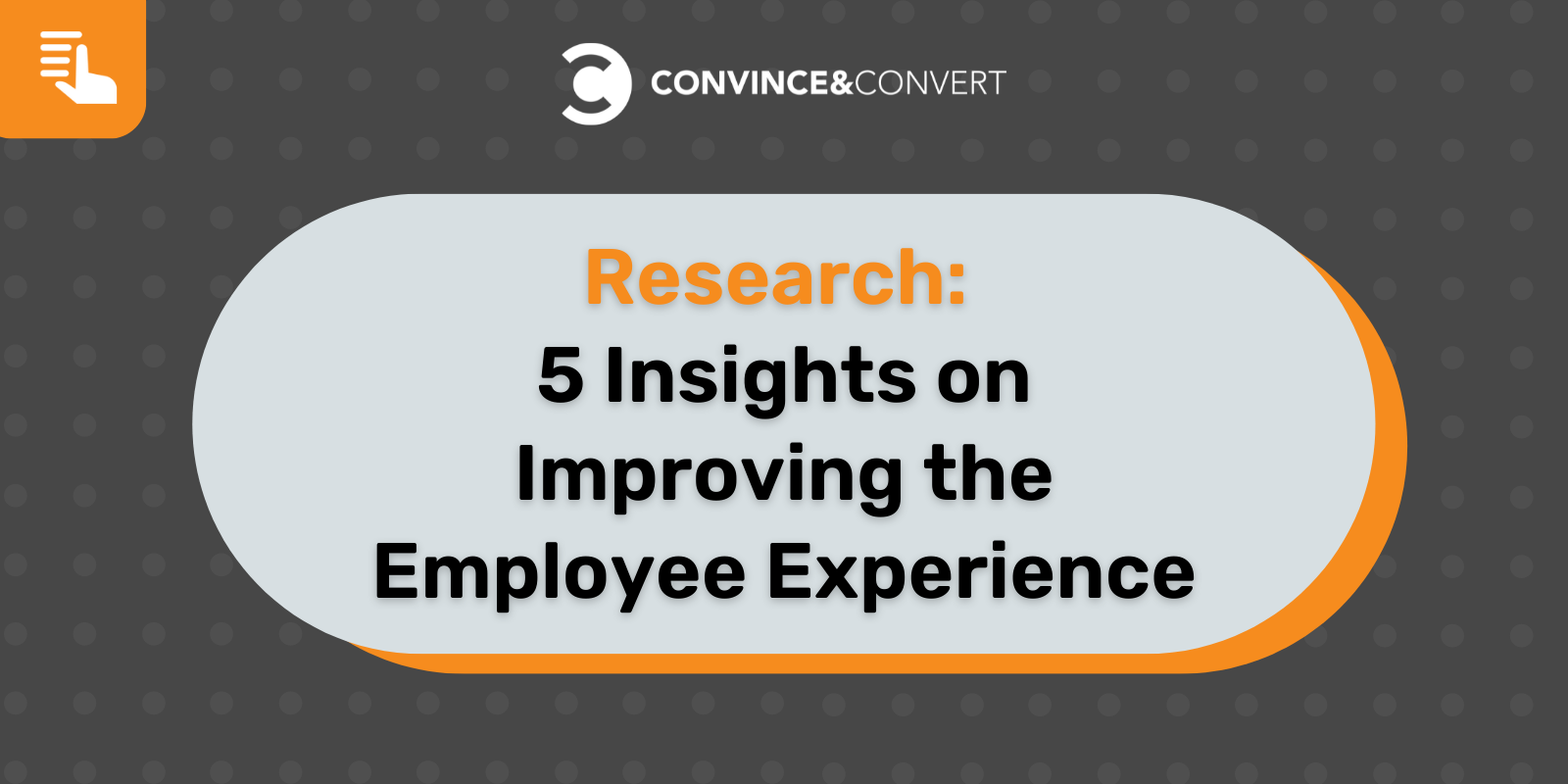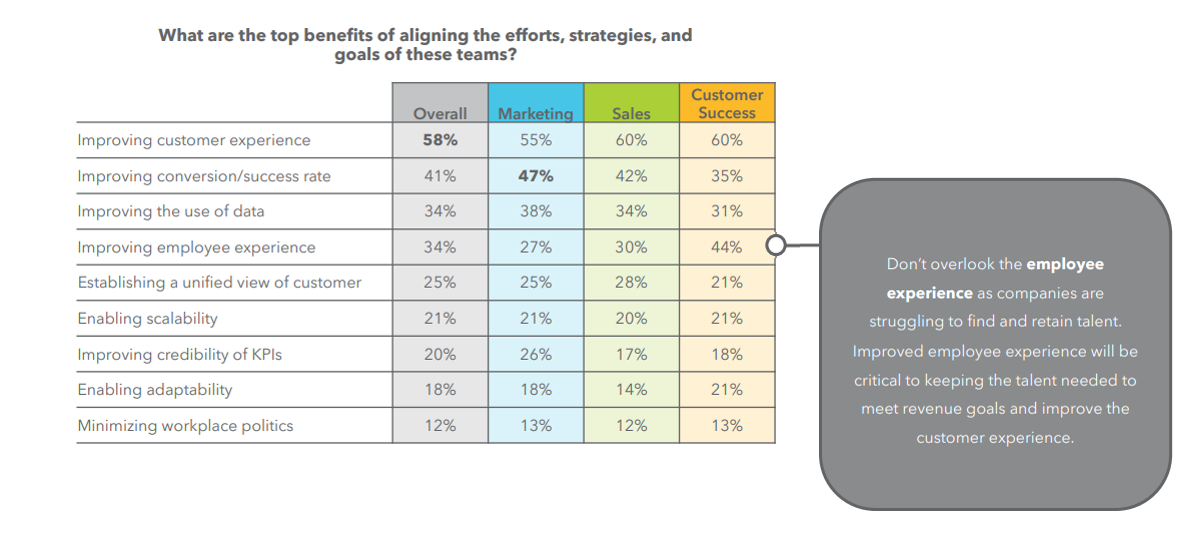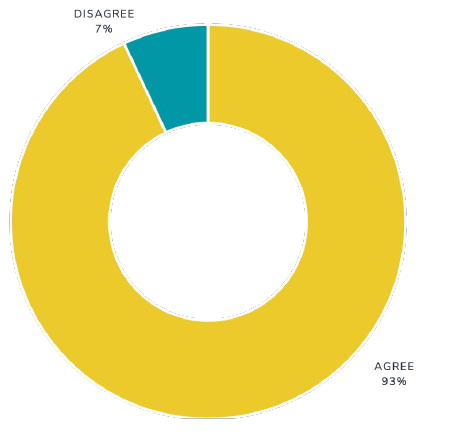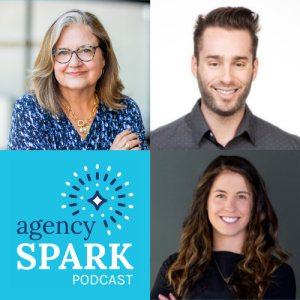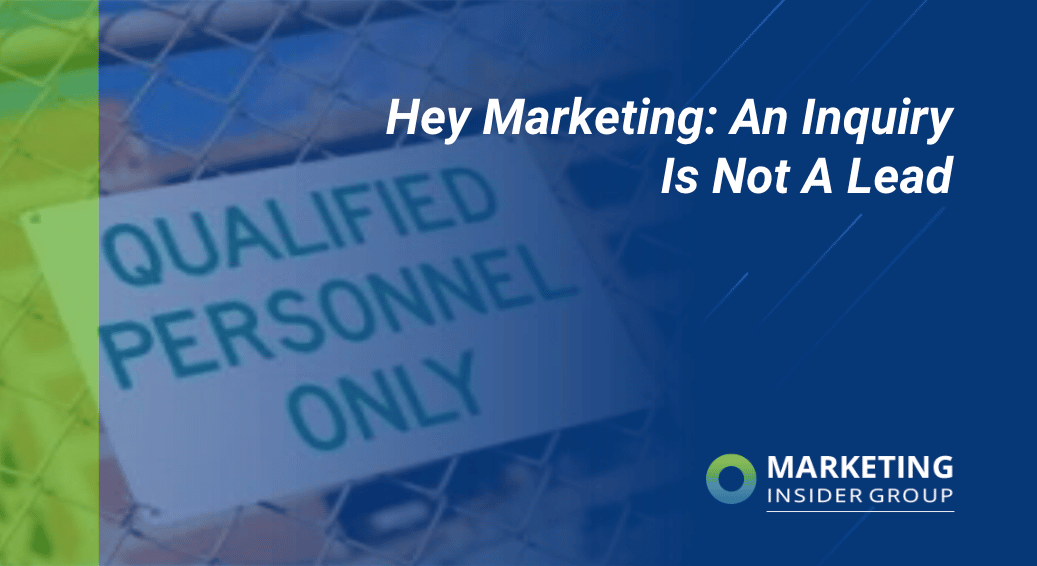
The main goal for Marketing in B2B companies is to generate leads for sales teams and increasingly to deliver direct revenue. Some marketers define anyone who fills out a form or attends an online or physical event as a lead.
But I’m here to tell you: an “inquiry” (someone who fills out a form) and a “lead” are not the same thing.
The main problem here is that there is no common understanding of the difference between an inquiry and a lead. This continues to be one of the biggest mistakes marketing makes. And this problem drives a deeper wedge between marketing and sales.
Why is this important? Research shows that as much as 71% of inquiries are are completely wasted and 36% of leads are never contacted at all.
The Bottom Line: When marketing gathers up new names from contact forms and dumps them over to sales, no one wins. And the potentially valuable interested inquirers are left wondering if there’s anyone home at the company they just raised their hand to.
I spent the first 5 years of my career in sales. When I moved to marketing, I committed myself to two things:
- Marketing should be accountable for driving quantifiable business value.
- Marketing needs to partner closely with sales.
I spent about half my career in marketing creating, tweaking and optimizing demand generation processes, most recently for the world’s largest software company. And in the process, I somehow managed to accomplish both. We delivered a solid return on marketing investment. And we accomplished this by focusing on giving sales what they wanted: truly qualified leads.
So, what is getting in the way of so many sales and marketing conversations? Definition and clarity around the definition of a lead…
An Inquiry Is Not A Lead
So you are running marketing programs, engaging content and campaign messages across a variety of paid, owned and earned media channels. Here’s just a few examples of the mistakes marketers make when defining inquiries as leads:
- Every person who signs up for your newsletter, downloads a white paper, or registers for your webcast is not a lead.
- Just because you got a list of attendees from an industry conference and they fit your target demographic profile does not make them a lead.
- Someone who reads 10 blogs on your website is not a lead. Someone who clicks on your product / solution pages is not a lead.
It doesn’t mean that you should ignore these folks either. More on that in a bit. But first, what is an inquiry and what is a lead?
What Is A Marketing Inquiry?
As the examples above show, a marketing inquiry is an individual who has expressed interest in your company, your content, or your product by providing you with their contact information when they took an action such as downloading an eBook or subscribing to your blog.
At SAP, we called these inquiries “raw responders.” They are names and email addresses, and if you are lucky, phone numbers and company names and titles. These people are interested in getting educated on how to solve a problem. Your job is to figure out how many of those inquiries have the potential to become leads you can pass to sales.
You should never expect a sales rep to do this hard work for you in marketing! Sales people are built to sell.

Sales teams that attempt to follow-up on inquiries often get frustrated that their time is being wasted on people who don’t actually have the budget or desire to buy something. So they assume all the leads are crap. And often they stop following up at all. Hence the large number of leads that are never contacted.
Sales people want the highest quantity of quality leads you can send them. It’s all about achieving the right balance! Send them low-quality inquiries and they will stop bothering to consider them quality leads. So what is a marketing lead then?
What Is A Marketing Lead?
A marketing lead is a qualified business opportunity. The only way to know whether an inquiry is a qualified business opportunity is to ask the inquirer if they are interested in buying something and a few other important questions. It’s important to know if they have budget to buy something. If they have the ability to buy something. And if they plan to make a purchase decision relatively soon.
This is all based on a deep analysis of specific kind of marketing lead that sales people viewed as high quality. The system is called “BANT” and it was first defined by IBM a few decades ago when phone calls where the easiest way to find out this information. Now we have online forms and many other data capture opportunities available to us in marketing.
BANT stands for Budget, Authority, Need, and Timing for solving their problem:
- Do you have a real Need?
- Do you have the Budget?
- Do you have the Authority to make a purchase decision?
- Are you making a decision in a sort Time period?
Some have added to or modified the BANT qualification model by adding an agreed follow-up step such as “can we meet for coffee on such and such date” but the bottom line is that sales should never see leads from marketing that have not had some direct qualification, to determine if there is a real business opportunity.
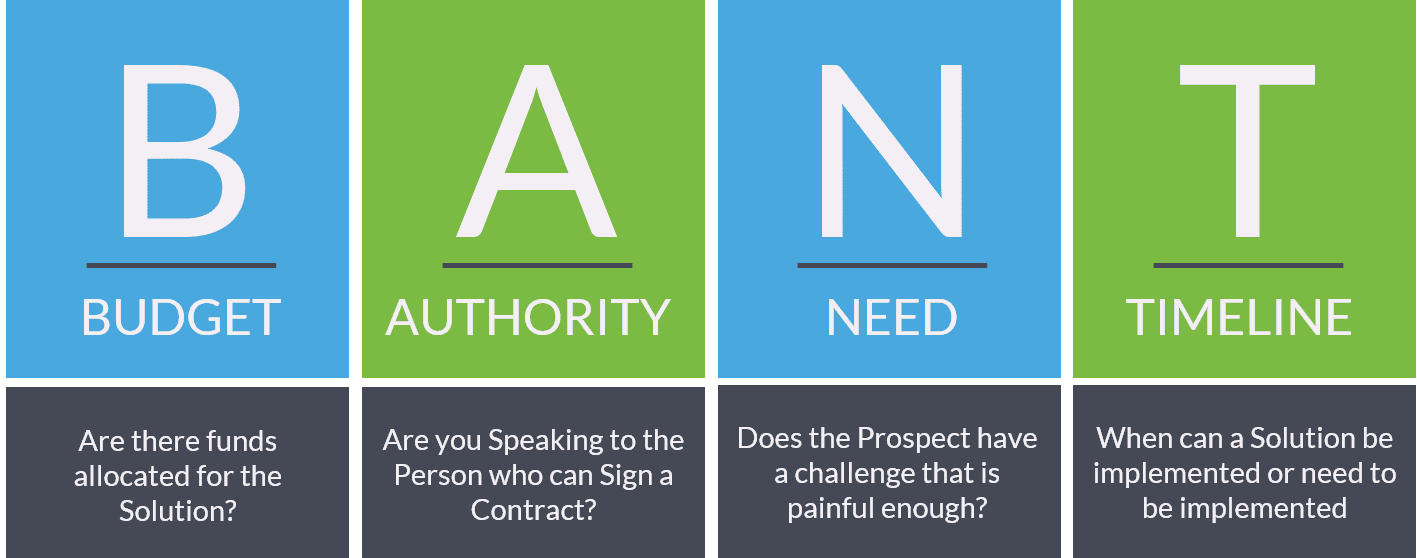
Decision-making in the B2B world typically includes many stakeholders. That first inquiry may be from an influencer rather than an actual decision-maker. You’ll also need to determine if there is a timeframe for making such a decision.
How Do You Score A lead?
Too many marketers use what’s called an activity-based lead scoring model. Visited our website? You get 10 points? Downloaded our white paper? Oh! You get 50 points. The problem with this is it has no consideration of the purchase intent of the visitor / downloader.
![Template] How to Create a Better Lead Scoring Model - Sponge](https://www.sydneysocialmediaservices.com/wp-content/uploads/2023/01/how-to-model-lead-scoring.png)
Instead, you want a more strategic approach to B2B Demand Generation. Assign a score to each inquiry using the criteria in BANT. You could make it 25 points each so that if they answer “yes” on 3 out of any 4 questions, they become a qualified lead and get passed on to sales.
- Do you have a real Need? Yes = 25 points
- Do you have the Budget? Yes = 25 points
- Do you have the Authority to make a purchase decision? Yes = 25 points
- Are you making a decision in a sort Time period? Yes = 25 points
Leads who score under 75 can go into a lead nurture pool and re-contacted in a few weeks.
Or you could add a next step question and make each question 2o points each so that if they answer “yes” on 4 out of any 5 questions, they become a qualified lead and get passed on to sales.
- Do you have a real Need? Yes = 20 points
- Do you have the Budget? Yes = 20 points
- Do you have the Authority to make a purchase decision? Yes = 20 points
- Are you making a decision in a sort Time period? Yes = 20 points
- Are you willing to speak to a sales person? Yes = 20 points
I would recommend weighting the Authority and Needs question a little higher since sometimes prospects are trying to find budget and don’t know the timing. Or you could add extra points for the sales call question.
- Do you have a real Need? Yes = 25 points
- Do you have the Budget? Yes = 10 points
- Do you have the Authority to make a purchase decision? Yes = 25 points
- Are you making a decision in a sort Time period? Yes = 10 points
- Are you willing to speak to a sales person? Yes = 30 points
In this example, anything with a 70 score or higher get passed on to sales along with EVERY yes to speak to a sales person with the caveat that this may not be fully qualified. At SAP, we handed these leads to lower level “internal” sales reps or BDRs who would further qualify the lead until it was ready for the hot shot sales rep.
What Is The Average Conversion Rate From Inquiry To Lead?
There is a ton of research out there on lead conversion rates, and some of it is even done by industry. Some suggest the average conversion rate from inquiry to lead is 4.4%. Meaning you need 351 inquiries to generate a new customer. Even “best practice” companies are only converting less than 10% of inquiries to truly qualified leads.
In my experience, even with a really optimized inquiry generation process will yield around a 4% conversion rate from raw responders. And you should achieve closer to 8% once you scrub out the “Mickey Mouses” “abc@gmail.com” and other false data registrants.
We used to scrub out independent consultants, non-work email addresses, non-US companies and duplicates (although sometimes this was a signal of someone who did convert to multiple marketing campaigns.) For duplicates, we ran a separate nurture stream to get them qualified and sent to internal sales.
There is a trade off that is worth thinking about: the lower your conversion rate from inquiry to lead, the higher the conversion rate should be from Lead to Sale. This maximizes the efficiency of the sales team so they are closing new business and not chasing unqualified prospects.
This also means you are likely not generating nearly enough inquiries. That’s why leads from content marketing is so important to generating cost efficient leads. Attract visitors to your content, convert them to subscribers and nurture them with offers that help them move through the buying process.
What Are The Best Lead Stage Definitions?
Almost a decade ago, I was directed to implement a common Demand Generation Waterfall from the board of a startup where I ran marketing. It consisted of tight definitions around lead stage that include:
- Inquiry: a net-new inbound responder to marketing content
- Marketing Qualified Lead: BANT qualified
- Sales Accepted Lead: Usually systematically (CRM) routed and agreed to be worked by sales
- Sales Qualified Lead: Sales re-qualifies the lead and in some cases gets a meeting
- Closed / Won Opportunity: Revenue!
I had this image pinned on my wall:
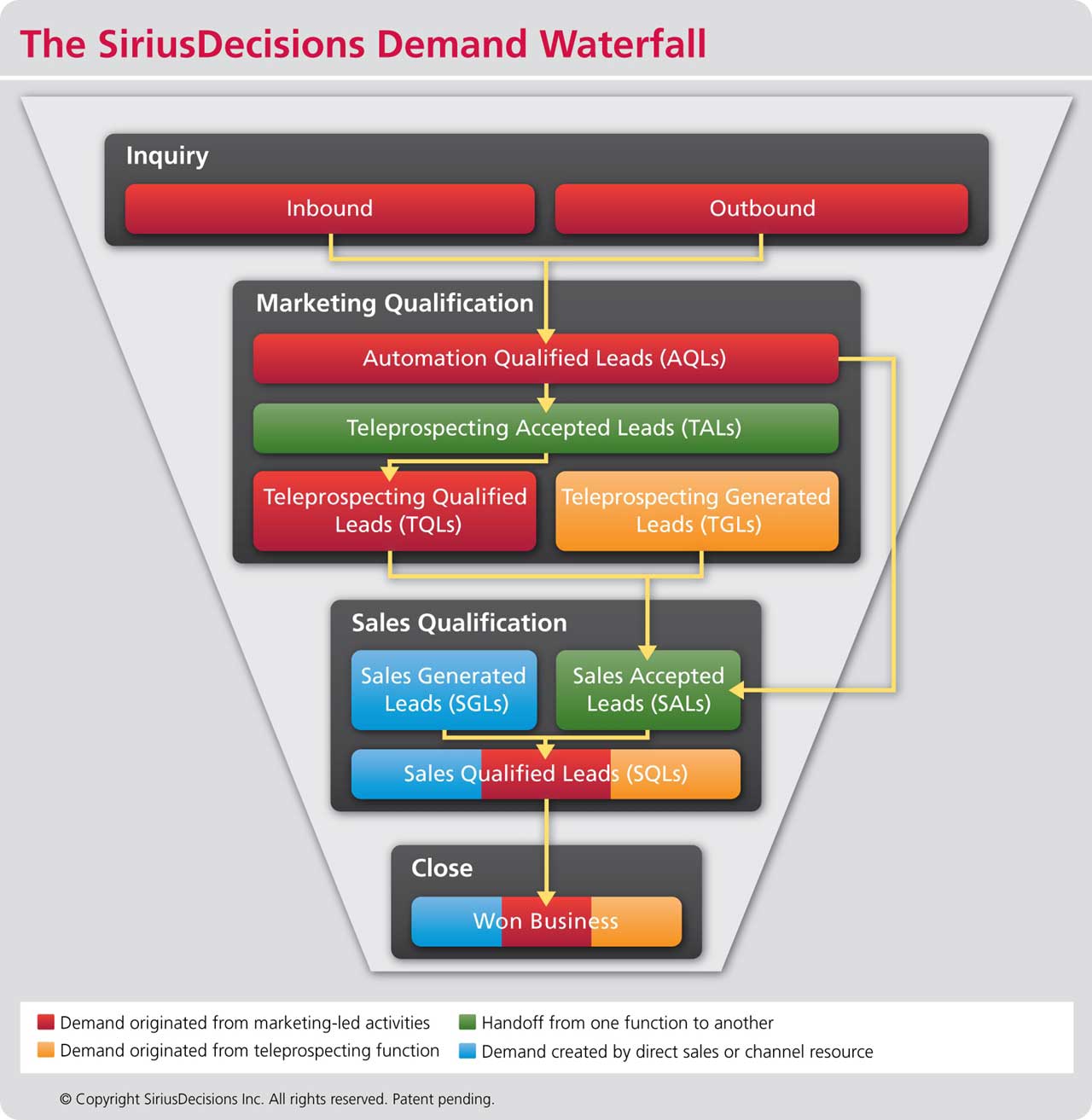
Marketing Inquiry Qualification Matters
The bottom line of all this for marketers: If you are sending marketing inquiries to your sales team prior to a true qualification, you are wasting money and the precious time of your sales team.
Marketers need to define a lead scoring methodology so that marketing-generated leads are passed to the sales team.
Looking to generate inbound leads from your website. We can bring you more relevant traffic website with weekly blog articles, a full year content plan, and monthly reporting? Set up a quick call, so we can get started today.
The post Hey Marketing: An Inquiry Is Not A Lead appeared first on Marketing Insider Group.
Did you miss our previous article…
https://www.sydneysocialmediaservices.com/?p=4384

